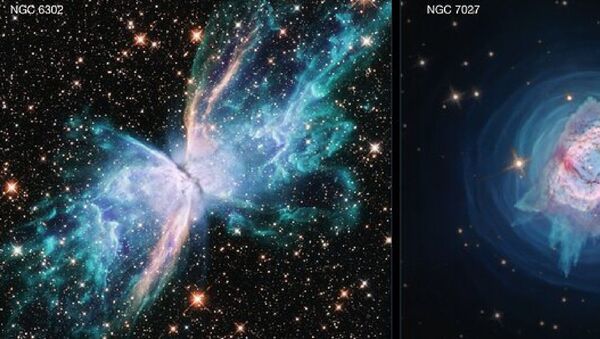A planetary nebula is the result of a star shedding its outermost layers once it has run out of fuel to burn, often taking either a ring-shaped or bubble-like form after the star’s gases expand into space. The planetary nebulae researchers focused their attention on were NGC 6302 and NGC 7027.
Although pictures of both nebulae had been captured by Hubble previously, neither of the nebulae had been viewed through the space telescope’s Wide Field Camera 3, which allows photos to be captured across a spectrum of near-ultraviolet to near-infrared light.
"These new multi-wavelength Hubble observations provide the most comprehensive view to date of both of these spectacular nebulas,” Joel Kastner, the leader of the research team, said in a statement. “As I was downloading the resulting images, I felt like a kid in a candy store."
New photos of NGC 6302, which is also known as the Butterfly Nebula since its expanding gas gives it the appearance of having wings, only showed its opposing S-shaped streams of gas when officials used the telescope’s filter to capture near-infrared emissions from ionized iron atoms.
Bruce Balick, a member of the researcher group, explained in a statement accompanying a NASA release of the images that the emissions detected were the result of an “energetic collision between slower winds and fast winds from the stars.”
"It's commonly observed in supernova remnants and active galactic nuclei, and outflowing jets from newborn stars, but is very rarely seen in planetary nebulas."
And then there’s NGC 7027, often referred to as the Jewel Bug Nebula for its round, bright, metallic-looking shell. Citing the newly analyzed photos, the team speculated that the nebula has undergone massive changes - possibly having consumed a companion star - as they have detected a new pattern taking shape.
"In some respects, the changes within this nebula are even more dramatic than those within the Butterfly," Kastner explained. "Something recently went haywire at the very center, producing a new cloverleaf pattern, with bullets of material shooting out in specific directions."
The group of researchers, who published their new findings in the journal Galaxies, hope the imagery will help the scientific community better understand and analyze the events taking place within evolving planetary nebulae.

